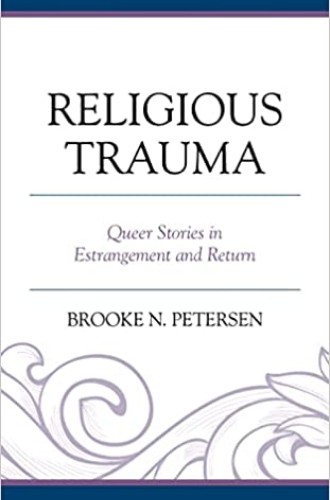Finding church after religious trauma
Brooke Petersen gathers the stories of eight queer Christians who left churches—and found new ones.
It is comforting to know you are not alone. A story reflected back to us that is similar to our own is inherently therapeutic. There is comfort in knowing that others have been through (and continue to go through) what we are going through, even down to the particulars. Much of the literature on religious trauma is helpful in this way, sharing the stories of those traumatized in religious spaces. It’s a relief simply to know people are talking about this, that religious trauma is recognized for what it is.
Brooke Petersen’s new book is an incredible addition to the emerging literature on religious trauma. It narrates, as the subtitle indicates, queer Christians’ stories of estrangement and return. It’s important to note the last two words, “and return,” because much of the current literature on religious trauma is about estrangement without return.
Read our latest issue or browse back issues.
As anyone living in solidarity with LGBTQ people knows, not everyone can return (or would wish to return) to religious community. For many, it is re-traumatizing. For others, it’s simply not where they put their energy for healing. They discover other life-giving spaces and invest their healing energies there.
But Petersen wanted to know “what it felt like to leave non-accepting congregations, if that leave-taking felt like a part of their trauma, and why they eventually returned to accepting faith communities.” Her study gathers the stories of eight participants who grew up in conservative and non-accepting religious communities, left those communities, and then returned to progressive churches. After initial chapters defining the emerging concept of religious trauma and evaluating the notion of homosexuality in psychology and pastoral theology, the book offers an in-depth look at attachment to a conservative religious community, estrangement from it, and return to a different, more progressive religious community.
That last part is the reason this book will become essential reading for progressive faith leaders everywhere. As a pastor who has witnessed the reality of healing from religious trauma in a religious community, it’s reassuring to see it supported through case study research. Perhaps especially notable, participants in this study shared experiences of trauma that were healed only when they had the opportunity to live their queer identity in progressive church community.
So what is religious trauma? Petersen argues that it is a form of insidious trauma. Insidious trauma is indirect trauma (as opposed to direct trauma, which results from events such as physical violence, war, and natural disasters) that “shapes the worldview of its victims, rendering the world a place that cannot be trusted, a place where psychological safety, security and survival is not guaranteed.” In other words, it is not the extreme nature of the event that defines something as traumatic, but the way the person who is traumatized understands the world and their relationship to it. Religious trauma wounds by compromising meaning making.
Religious trauma is particularly insidious because it is a betrayal at the deepest level of attachment. Often those who have experienced religious trauma were intimately connected to their religious community—and through it, to God. When they began to discern their queer identity, there was no place for it; it was to be “prayed away.” Secrecy and shame were the internalized message. And for those unwilling to deny their queer identity, ultimately it resulted in rejection and expulsion.
When religious communities condemn or silence their queer members, they allow no room for active identity formation. As each of Petersen’s case study participants left their religious communities, space opened up for them to increasingly become active participants in their own identity formation—both as queer people and as religious people. One of them, Sarah, says this: “When I go to churches I don’t just join, I really go in, I was there every Sunday setting their soundboard up, tearing it down, I was really integral.” When she had to leave her faith community, she notes, she “basically had to give them two weeks’ notice.”
In my experience as a pastor in a progressive congregation in Arkansas, I frequently see this reality. Queer people coming to us from conservative churches and processing religious trauma get deeply involved; they lead. The depth of identity formation through religious community may be why rejection by their church is especially traumatizing for some queer people.
Petersen concludes by offering some recommendations for progressive communities of faith who seek to be healing spaces from religious trauma. She understands such work to be justice work.
One important step is ensuring that there are healthy examples of queer people in the faith community, especially in leadership. None of the participants in her study saw queer people actively participating in a supportive religious community before they left their conservative contexts. They were not even sure such communities existed.
Second, faith communities can bear witness, which means stating through words and actions, “I see you, I believe you, it’s not your fault, and you are not alone.” Faith communities can acknowledge the trauma. It’s also essential for faith communities to continually acknowledge their past complicity in anti-queer history. Naming this history as a church, and then stating clearly a commitment to welcome and inclusion, was crucial for the return of many of Petersen’s participants.
Third, communities and pastoral caregivers should “remain aware that agency is always centered in the survivor of trauma.” Return cannot be forced, and pushing for return in ways that do not center the survivor’s agency is re-traumatizing, repeating some of the past patterns of religious harm.
Finally, recognize that returning to church for the first time is especially fraught. It’s a fearful thing to step back in. Case study participants reported that their first visits were very difficult, full of grief and tears and complex emotions. But soon, regular participation in the rituals of the faith community while being open about their identity was precisely what they needed to re-narrate and heal.
The stories recorded in Petersen’s book may be familiar to some progressive pastors. But never before have they been so thoroughly gathered in one place, with a special focus on the healing function of return. This is an important book, and one that will be shared with religious trauma support groups and queer ministries for years to come.
* * * * * *
Jon Mathieu, the Century's community engagement editor, interviews Clint Schnekloth about this book review and about Schnekloth's own observations regarding religious trauma.







